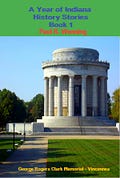November 28, 1799 - John Rice Jones Appointed to Carry Mail
Early Indiana Postal Route
November 28, 1799 - John Rice Jones Appointed to Carry Mail
The Buffalo Trace, which stretched from the Falls of the Ohio to the frontier town of Kaskaskia, Illinois, served as a highway for pioneers to enter the Northwest Territory and a mail route. On November 28, 1799, the United State Postmaster General Joseph Habersham appointed John Rice Jones to carry mail along the Trace.
John Rice Jones (February 11, 1759 – February 1, 1824)
The son of John and Ann Jones, John was native to Mallwyd, Wales. in Great Britain. Jones gained admittance to the bar and practiced law in London. He married Eliza Powell in 1781. In 1784, Jones traveled to Philadelphia. The next year he returned to England and brought his wife and son to America. He also had a daughter, Maria, who was in frail health. He left her in the care of relatives. He would move to Louisville, Kentucky in 1784. That same year he joined the force raised by General George Rogers Clark to quell native unrest. Clark established a fort at Vincennes and appointed Jones as Commissary General. His family joined him in Vincennes, however Eliza died in childbirth in 1787. Jones remained in Vincennes until 1807, when he would move to Kaskaskia, Illinois. During his years in Vincennes, in addition to his postal duties, Governor Harrison appointed him to serve as the first Attorney General in the Indiana Territory, and to the Territorial Legislature in 1805.
The Buffalo Trace
The Buffalo Trace began in the prairies of Illinois as the herds of buffalo headed east toward the licks. It crossed the Wabash River near the site of Vincennes, Indiana, providing the French with an ideal spot to establish the trading post that became the city. It crossed southern Indiana, nearing the Ohio River at its shallowest point, the Falls of the Ohio. After crossing the river, the bison traveled across northern Kentucky until they reached the area of the licks. In places, the Trace was up to twenty feet wide. Amerindians used the trace to both hunt the bison and travel cross-country. Since it connected the Ohio, Wabash and Mississippi Rivers the trace provided a highway for the white settlers that wished to go west. Today portions of U. S. 150 follow the Trace, which is now part of the National Scenic Byways Program.
The Mail Route
Jones received a salary of $600 per year to deliver the mail every four weeks and to maintain the Trace. Jones improved the Trace and Habersham designated the Trace as a post road on March 22, 1800. Many believe the 130 mile route was the first "western" mail route. Two men carried the mail on foot over the Trace, by now a weekly route.
From the Book:
A Year of Indiana History Stories - Book 1
A Year of Indiana History Stories Book 1 includes three hundred and sixty-six stories of Indiana history. Written in a this day in history format, this journal is ideal for kids and adults alike. Children will especially benefit as they can learn history local to Indiana by reading one story a day for a year.
536 Pages




